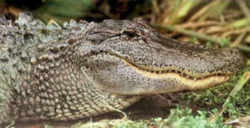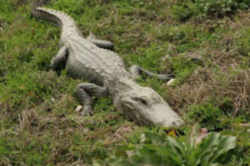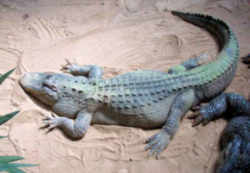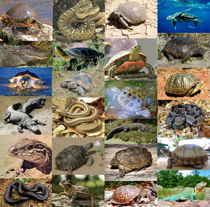
Florida Symbols
Florida State Reptile
American Alligator

(Alligator mississippiensis)
Adopted in 1987.
In 1987 the Florida legislature designated the American alligator (Alligator mississippiensis) as the official state reptile. Long an unofficial symbol of the state, the alligator originally symbolized Florida's extensive untamed wilderness and swamps. Alligators are found throughout Florida and in parts of other southeastern states. They prefer lakes, swamps, canals, and other wetland habitats.
Alligators eat fish, turtles, and a variety of other animals. In late June and early July, female alligators usually lay thirty to fifty eggs in mound-shaped nests made of reeds and other vegetation. Baby alligators hatch after an incubation period of about two months. When hatched, alligators are already fully developed and about eight inches long. Mature alligators usually range from six to twelve feet in length, with females rarely exceeding nine feet.
Because alligators are cold-blooded, we often see them sunning on logs or on banks near water. Gators can move surprisingly fast over short distances, and their powerful jaws and swinging tails make them dangerous to approach. Female alligators are particularly aggressive when guarding their nests. Alligators should not be fed, since this causes them to lose their fear of humans, and feeding is against Florida statutes.
Today, the alligator is no longer on the endangered-species list, because the reptile has successfully repopulated itself after having been over-exploited by illegal hide hunters. Alligators are now under controlled management by the Florida Game and Fresh Water Fish Commission to preserve the species and the wetland habitats that they and other Florida wildlife inhabit.
Florida State Reptile: American Alligator

Alligators
are found throughout Florida and in parts of other southeastern states. They prefer lakes, swamps, canals, and other wetland habitats. They eat fish,
turtles, and a variety of other animals. In late June and early July, female alligators usually lay thirty to fifty eggs in mound-shaped nests made
of reeds and other vegetation. Baby alligators hatch after an incubation period of about two months. When hatched, alligators are already fully developed
and about eight inches long. Mature alligators usually range from six to twelve feet in length, with females rarely exceeding nine feet.
Because alligators are cold-blooded, we often see them sunning on logs or on banks near water. Gators can move surprisingly fast over short distances,
and their powerful jaws and swinging tails make them dangerous to approach. Female alligators are particularly aggressive when guarding their nests.
Alligators should not be fed, since this causes them to lose their fear of humans, and feeding is against Florida statutes.
Today, the alligator is no longer on the endangered-species list, because the reptile has successfully repopulated itself after having been over-exploited
by illegal hide hunters. Alligators are now under controlled management by the Florida Game and Fresh Water Fish Commission to preserve the species
and the wetland habitats that they and other Florida wildlife inhabit.
Description of the American Alligator

Adults males typically reach 4 to 4.5 metres (approximately 13 to 14.7 feet), although there are several unconfirmed reports of larger 5 m (approx 16.4 feet) and even 6 m adults (19.8 feet is the largest "reported", though there are doubts over its veracity) having been found or killed in the 19th and 20th centuries. Such sizes seem unlikely for this species. Females reach lengths of just under 3 m (approx 9.8 feet). The snout is characteristically broad, although this varies slightly between populations. Captive animals have been shown to grow significantly broader jaws compared with wild alligators, mainly due to differences in diet. When the mouth is closed, the edge of the upper jaw overlaps teeth in the lower jaw, which therefore fit into depressions in the upper jaw. This is unlike Crocodylus and Gavialis in which the lower teeth fit into depressions on the outside of the upper jaw. A bony nasal bridge is present, similar to that seen in the spectacled caiman (Caiman crocodilus) but not as pronounced. Juveniles are essentially miniature versions of their parents, although they possess bright yellow cross-bands on a black background - disruptive camouflage. More western populations (which may have been historically isolated from eastern populations) are reported to have white speckling around the jaws, with paler coloration on their bodies and tails. In all individuals, older alligators gradually lose the yellow banding and turn olive brown and black, although areas around the jaws and on the neck and belly are creamy white. The ventral surface is pale, but most scales especially nearer the tail possess significant amounts of black. Ventral osteoderms (bony plates) are present in the belly scales of all American alligators, although the extent varies between populations and the skin is considered quite valuable. The color of the eyes is similar to many other crocodilians, being generally olive green but variable. Wild adult populations have been observed to fall into two general forms: those which are long and thin, and those which are short and stocky. Variation in growth rate, diet, climate and other factors are likely responsible for these differences
Habitat
Primarily freshwater swamps and marshes, but also in rivers, lakes and smaller bodies of water. They can tolerate a reasonable degree of salinity for short periods of time, being occasionally found in brackish water around mangrove swamps, although they lack the buccal salt-secreting glands present in crocodiles. Construction of burrows is well documented in this species. The burrows are used for shelter and hibernation when the seasonal temperatures fall. Even outside their burrows, they can tolerate limited periods of freezing conditions (see "icing response" in Miscellaneous Facts, below). They modify their habitat through the creation of 'alligator holes', which provide a refuge for other animals during dry periods. These are excavated using both snout and tail. Once these dry out, however, the alligator crosses land in order to find another body of water. Alligators near human habitation are often seen crossing roads, entering suburbs and finding shelter in swimming pools during the drier months.
Florida Law
The law designating the American alligator as the official Florida state reptile is found in the Florida Revised Statutes, Title 2, Chapter 15, Section 15.0385
Title IV EXECUTIVE BRANCH
Chapter 15 SECRETARY OF STATE Entire Chapter
SECTION 0385
Official state reptile.
15.0385 Official state reptile.- The American alligator is hereby designated and declared as the official Florida state reptile.
History.- s. 1, ch. 87-18.
Taxonomic Hierarchy: American Alligator
Kingdom: Animalia
Phylum: Chordata
Class: Reptilia
Superorder: Crocodylomorpha
Order: Crocodilia
Family: Alligatoridae
Genus: Alligator
Species: A. mississippiensis







